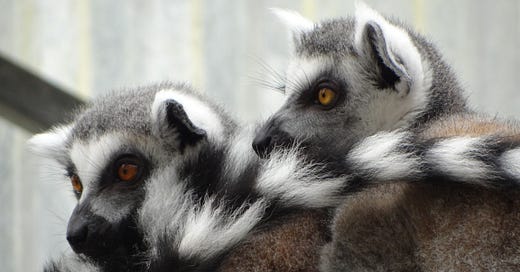Same-Sex Sexual Behavior is Common in the Animal Kingdom
Same-sex sexual behaviors are found far and wide across the animal kingdom, now researchers are trying to figure out why
Hiya!
I was in high school when my home state legalized same-sex marriages. Even then, I remember thinking how bizarre it was that it wasn’t already allowed and was something that required a vote at all. Members of the LGBTQ+ community have always been part of my life, many of which I count among my closest relationships. My logic was (and still is) that the LGBTQ+ community are people, just like you and me, so why wouldn’t they be able to get married?
Still, the debate raged across the nation, and some impressionable part of me formed the idea that homosexuality is unique (but not wrong) among the human species compared to the rest of the “natural world,” which I assumed at the time meant the animal kingdom. I learned later on how flawed this assumption was, and now, with the publication of a new paper, I thought I’d write a bit about just how common homosexual behavior actually is in the natural world.
A Plethora of Examples
So, just how common are same-sex sexual behaviors (as scientists call it) in the wild? Well, so far, researchers have identified over 1,500 animal species that engage in sexual behaviors with the same sex. New research I’ll tell you about in a bit found that both male and female animals partake in same-sex sexual behavior pretty much equally. In his popular book Queer Ducks (and Other Animals), best-selling author Eliot Schrefer wrote:
“[Same-sex sexual behaviors] aren’t rare anomalies. An explosion of research over the past 20 years has shown significant amounts of same-sex sexual behavior throughout the animal kingdom.”
By now, there are plenty of examples, from penguins to sea urchins. However, the behavior is particularly widespread among non-human primates, with 51 species identified so far, ranging from small lemurs to large apes.
Dolphins, it appears, have lots of sex — little of which results in pregnancies. Behavioral ecologist Janet Mann, who studies the dolphins at Australia’s westernmost tip, Shark Bay, stated:
“The amount of homosexual behavior [in dolphins] is so high. In fact, we see very few heterosexual matings altogether. We know they happen because there are offspring. But we see very few.”
We know already that there is a vast diversity in how heterosexuality presents, both in Humans and other animals, including promiscuity, monogamy, polyamory, and so forth. Additionally, sexual behaviors don’t always mean intercourse. Now we know the same is true for homosexual behaviors.
Female bonobos are known to rub their genitals together, and researchers believe it’s a way to encourage sharing and reduce tension. During mating season, a bat species called Bonin flying foxes will curl up in same-sex cuddle-puddles to keep warm, and oral-genital stimulation is common among the male clusters. In Hawaii, the female Laysan albatrosses mount each other sexually, share their nests, and co-parent their offspring.
I could go on, but I think you get the point. Same-sex sexual behavior is widespread throughout the natural world and looks different for each species. It’s only been a couple of decades since researchers revved up their interest in the topic, but in that time, we’ve already found over 1,500 species and counting. I have a feeling the list is nowhere near complete.
While I’m thrilled researchers are making such progress in identifying species that engage in same-sex sexual behaviors, it’s a smidge puzzling why it’s taken us so long to get here. I mean, animal sciences have a long history, dating back to before Darwin, so how is any of this new-ish information?
Keep reading with a 7-day free trial
Subscribe to Curious Adventure to keep reading this post and get 7 days of free access to the full post archives.



